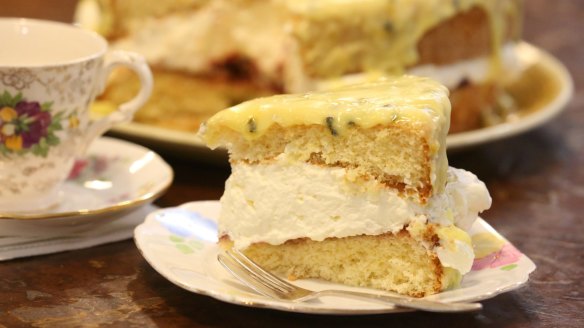Should you store bread and cakes in the fridge?

I made a cream sponge one evening and put it in the fridge to stop the cream going off. The next day the cream was OK but the sponge went stale overnight. P. Fankhauser
The best way to bugger up bread and cakes is to store them at low temperature. It makes them go stale. Ever noticed how the bread in pre-made sandwiches at service stations is always tough? No? You don't eat where you buy your petrol? Fair enough. During baking, starch absorbs water and forms a gel that hardens with the heat. At room temperature the water slowly escapes this hardened gel and slowly migrates to the exterior. That is why a crusty baguette becomes soft on the outside and the crumb dry on the inside after a couple of days. This process is sped up the closer the temperature is to freezing. You were right in chilling the cream in the sponge as that stuff goes off like the proverbial bucket of prawns in the sun. But you need to keep cakes, and bread for that matter, at room temperature. Keep them covered in a tin or in a paper bag to slow down the loss of moisture from the crust. The sugar in cakes holds onto moisture so very sweet cakes will become stale at a slower rate than cakes lower in sugar, such as a sponge.
I read that some beans contain cyanide. Are they dangerous? K. Milne
We all have our responses to threats. Some of us go into fight or flight mode. Others buy European-made four-wheel-drive cars. Plants produce chemical compounds to ward off attack. Phaseolus lunatus means half moon bean but they are better known as lima or butter beans. When raw, they contain cyanogenic glycosides, compounds that convert into a toxic meal when bugs start chewing on them. This compound is rendered safe when beans are boiled for 30 minutes. Kidney beans, however, offer a different challenge. They contain phytohaemagglutinin (PHA) made up of two proteins that can cause blood cells to clump. Not good. You can also find PHA is lesser quantities in cannellini beans and broad beans. These proteins need to be knocked out and this occurs with cooking. Boiling at 100C, actually. Red kidney beans added to a chilli con carne in a slowcooker set to 75C are still going to contain PHA. Boil them first for 30 minutes. Tinned beans are already cooked so are rendered safe.
Feedback
The emails about how to dispose of oil used for deep-frying keep on coming in. A. McKay writes, "Once cooled, oil used for deep-frying can be filtered through a paper towel. The towel is folded in half and again folded in half, then placed in a funnel. The oil can be used again for deep or shallow frying. I would not recommend it as a salad oil." A few weeks back I was trying to remember the name of a mezcal bar in Oaxaca in Mexico. M. McEvoy wrote, "The place you described was Los Amantes. It was a very small bar with old pictures along the sides. They offer a flight tasting different mezcals and since my partner doesn't drink spirits, they took a sip from their glass and passed the glass to me. It is amazing I can still remember the night." I am glad you can. I still can't.
Send your vexing culinary conundrums to brainfood@richardcornish.com.au or tweet to @realbrainfood.
Appears in these collections
- More:
- Food
- Brain food
